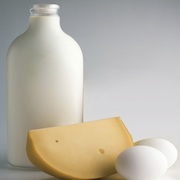 Arina Zaiachin/PhotoSpin
Arina Zaiachin/PhotoSpin
Milk allergies are more than just lactose intolerance. Detected in about 2.5 percent of children under 3 years old, milk allergies can cause severe illness, according to the Food Allergy and Anaphylaxis Network.
Both lactose intolerance and milk allergies can have the same symptoms, but milk allergy involves the immune system whereas lactose intolerance involves the digestive system, Kidshealth.org says.
Lactose intolerance is when the digestive system doesn’t produce enough enzyme to break down the sugar in milk, according to Kidshealth.org.
Milk Allergy symptoms include hives, wheezing and vomiting immediately after consumption of milk.
According to the Mayo Clinic, developing symptoms include: diarrhea, loose stools with blood, cramps, coughing, runny nose, watery eyes and an itchy skin rash around the mouth.
Milk allergies can also cause colic in babies, where they cry or show symptoms of distress as a seemingly healthy baby.
Children with a milk allergy usually will outgrow it in the first few years of life, the Food Allergy and Anaphylaxis Network says.
With milk allergies, the immune system overreacts to milk proteins. Those who are allergic to cow’s milk react to one or more proteins in it, Kidshealth.org says.
People may be allergic to one or both parts of milk, curd and whey. The chunks formed in sour milk, known as curd, contain 80 percent of milk's proteins, including caseins whereas whey, the watery part of milk, contains the other 20 percent, Kidshealth.org says.
Although milk is found in so many foods, it can be substituted with water or fruit juice in equivalent amounts for baking.
There are, however, some hidden sources of milk. For example, deli meat slicers may contain milk through cross-contamination, and some medications contain whey.
According to Food Allergy and Anaphylaxis Network, canned tuna fish, meats and non-dairy products may contain the milk protein casein as well, so be aware.
Just as with any allergy, read labels carefully and if anaphylaxis does occur, although it is rare with milk allergy, according to the Mayo Clinic, it requires emergency treatment and an epinephrine shot.
No matter how mild the reaction tell a doctor, to avoid future and potentially worse reactions.
Sources:
Milk Allergy
Kidshealth.org. Retrieved October 2, 2012.
http://kidshealth.org/teen/food_fitness/nutrition/milk_allergy.html
Milk
The Food Allergy & Anaphylaxis Network. Retrieved October 1, 2012.
http://www.foodallergy.org/page/milk-allergy
Milk Allergy: Symptoms
Mayoclinic.com. Retrieved September 13, 2012.
http://www.mayoclinic.com/health/milk-allergy/D
Reviewed October 3, 2012
by Michele Blacksberg RN
Edited by Jody Smith





Add a CommentComments
There are no comments yet. Be the first one and get the conversation started!